 |
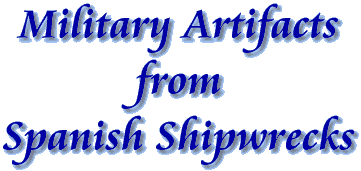 |
 |
 |
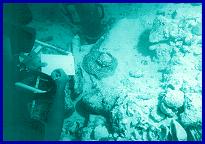 |
The artifacts shown here represent a sampling of the military uniform-related materials recovered from these wreck sites. Since the collection, preservation, and interpretation of these materials is a still-ongoing process, the contents of this page will be upgraded and expanded as more information and artifacts come to light. It should be noted that overtly civilian materials, such as ornately fashioned buttons and buckles clearly not intended for use within a purely military context, have been omitted from inclusion here. It is also noted that some of the artifacts shown have been recovered from wreck sites outside Florida's waters but within the greater Gulf of Mexico to Caribbean regions of Spain's New World empire. |
| Above: Underwater Archaeologist Documents Discoveries. (Source: Michell W. Marken, Pottery from Spanish Shipwrecks 1500-1800, 1994) |
| The earliest artifact appearing on this page is the small doublet button shown at right, recovered from the 1622 wrecksite of the treasure-rich Nuestra Señora de la Atocha. The button consists of a thick and deeply cupped silver outer shell with a robust, bent rectangular cuprous wire shank indelicately embedded in solder, which was sufficient in quantity to both secure the shank in place and partially fill the button's reverse interior cavity. While it is problematic to ascertain whether this was military or civilian in its intended mode of use, its silver construction implies that it was made for a person of means. |

|
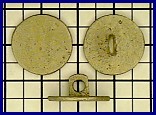 |
 |
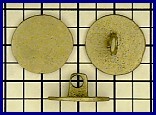 |
 |
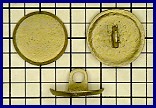 |
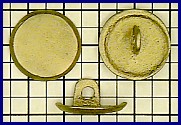 |
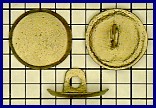 |
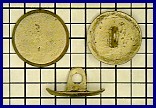 |
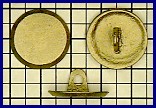 |
|
| The buttons above were recovered from the wreck sites of the Nuestra Señora de Guadalupe and El Conde de Tolosa of the Quicksilver Fleet, which sank en route from Spain to Mexico on 24 August 1724 off Hispaniola (now the Dominican Repubic) with a cargo of 400 tons of liquid mercury. These military uniform buttons represent drilled shanked variants of the "frying pan" shaped types used by Spanish land and marine forces from the late 1600s through much of the 18th century. These lost wax cast buttons have flat faces, beveled edges, and recessed backs. They are here classified as members of the Guadalupe type. | ||
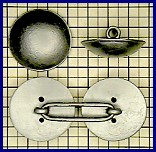 |
Recovered from the 1715 Treasure Fleet's cabin wreck site, the large, hollow silver buttons shown at left were fitted with a cast silver link to form a cape or cloak collar link set. The two perforations in the back of this button type (called "blow holes" in the private collecting community) served to allow for the release of excess expanding gasses when the button's back and front halves were joined. The buttons feature separately cast silver looped shanks that were separately attached to their backs. Smaller, coat-sized, unlinked examples of this form have also been recovered from these wreck sites. It is postulated that these were worn by military officers serving or traveling on these ill-fated ships. |
|
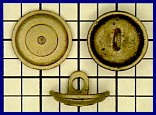 |
 |
|
|
|
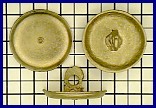 |
This oversized button from the 1733 wrecksite of the type's classification namesake, the galleon El Infante. It probably formed part of a collar or cloak fastening link. The example combines excellent body workmanship with a very crude, oversized drilled shank and the small, central nipple-like facial protrusion of its smaller counterparts shown above. |
| Among the recoveries from the 1733 fleet have been small cast brass octagonal buttons like the example shown at the left. This button form is commonly encountered at Spanish military sites in eastern Florida and is associated with use by land forces (see San Agustín type on the "Military Buttons of Florida and Louisiana, ca. 1700-1795" page at this site). Was this the button of a hapless soldier temporarily assigned to naval duty or just catching a ride home, only to be lost at sea? Or was this a type of naval button of the period incompletely interpreted at this time? |
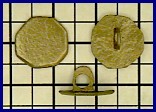 |
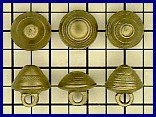 |
Diminutive, hollow, two-piece, seam-soldered conical cuff buttons like those shown at left have been recovered from 1733 Fleet wreck sites. Each of the two elements comprising the button's body was cast separately, finished along its joining edges, and then the two parts were sweat solder joined. The examples at left illustrate three varieties of these small buttons. |
| Recovered from the 1733 fleet, this is the reverse or core portion of a bone-backed officer's button whose original crimped and very thin gilded brass or silvered copper foil facing did not survive the rigors of the undersea environment in which the example was submerged. Such buttons, which were unmarked in the Spanish military establishment, were worn from the 1730s until the period immediately following the American War of Independence. Similar examples have been recovered from the wreck site of El Cazador (1784). Several sizes of these forms, none of which retains its original foil facing, have been recovered from ship wreck sites of the period cited. | 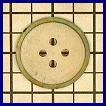 |
 |
This small ceramic button from the 1733 fleet features a raised, turret-like perforated boss as its mode of attachment. It is postulated that this served as a common seaman's trousers or shirt button. Buttons of this sort were probably used by merchant as well as military mariners. |
| This large and unusually heavily lost wax cast cloak or cape button was recovered from the remains of the 1751 Navío San Gerónimo off the coast of Mexico. The type is likewise assigned the classification nomenclature of the San Gerónimo for the purposes if this study. It retains the protruding outer rim and concentric, circular, target-like inner rings of its 1733 ancestors but is an evolved form of that earlier military uniform button pattern. |
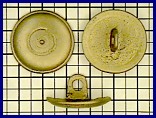 |
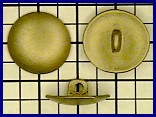 |
The coat buttons shown at left and right are ground-recovered examples of types worn by Spanish naval forces during the ca. 1770-1790 period. The remains of cotype examples have been recovered from the 1784 site of El Cazador and may be expected to be recovered from other sites of the period. |
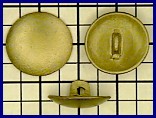 |
| Plain, heavily constructed convex cast brass buttons like the ones shown (which are ground-recovered cotypes of wrecksite examples used here for illustration purposes) were used by naval personnel from the 1750s through the period of the American Revolution. This form has been encountered on El Cazador, a Spanish brigantine carrying a 450,000 peso cargo from Vera Cruz and lost 50 miles short of its destination at New Orleans in 1784. | 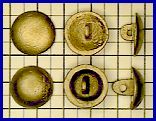 |
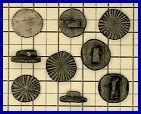 |
Small carved, often "starburst" incised, bone buttons (left) were recovered from the 1784 wrecksite of El Cazador, as were plain, originally cloth-covered drilled bone buttons (right), shown here with ground-recovered fragments of bone from which such buttons were cut. Drilled bone buttons as shown at right are encountered at many early colonial sites, while carved buttons like those at left appear to be uniquely Spanish in origin. |
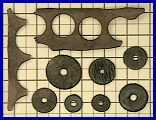 |
| The coat button shown at right was recovered from the June 1784 wreck site of a Catalonian settee that ran aground on central Florida's eastern coastline while carrying elements of the Spanish Asturias regiment home from duty in Mexico after a brief stay in Havana. While the name of this vessel has not yet been ascertained, its almost wholly military artifact assemblage includes buttons and buckles of the 1780-1790 period. Included in this assemblage are examples of the Florida type of military coat button shown elsewhere on this web site; the example shown is a variant believed to have been worn by naval or marine personnel. |
|
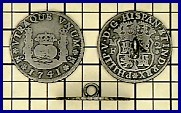 |
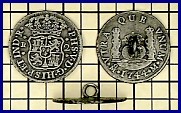 |
|
Recovered from a mid-18th century shipwreck off the coast of Cuba, the Mexico City mint silver two real coins of 1741 and 1744 shown above became coat or jacket buttons via the simple addition of looped silver wire shanks. Similar examples have been recovered from land sites in the Floridas and elsewhere in the former Spanish colonies. Together with other coat buttons and cuff link forms, they are members of a large family of patriotic accessories that were very popular in use by Spanish soldiers and citizens during the 18th and early 19th centuries. |
|
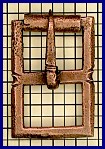 |
This robustly constructed waist belt or heavy strap buckle features a friction roller on its outer frame element. Made of an alloy bearing a very high copper content, this regulation issue pattern example was recovered from a presently unidentified, ca. 1660-1690 Spanish wrecksite in the Atlantic coastal waters of central Florida. Further investigation is planned to more fully interpret this site and its contents. |
| The strap buckle at right was recovered in association with the large belt or large strap buckle shown above and is believed to also occupy a ca. 1660-1690 temporal horizon. Standardized and characteristically plain conventional military buckles did not appear as regulation items until after 1700, and this would be considered to be a late seventeenth century military strap buckle style. | 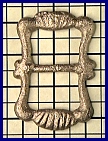 |
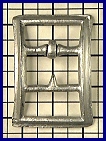 |
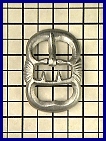 |
 |
|
Triple frame shoe buckles like the cast silver examples from the 1715 Plate Fleet shown above were introduced by Spain in the late 1600s and were almost exclusively used by the Spanish thereafter. This mode of shoe buckle construction alleviated the need for the complex and more expensive articulated, center pin-mounted hasps and tines common to the shoe, knee, and neck stock buckles of other European states. The prosaic rectangular examples at left and right may have been worn by military officers, although the flared rectangular shapes exhibited by these examples became militarily obsolete by the 1720s. The small and delicately fashioned ovoid example at center was almost certainly made for an affluent civilian. This buckle was of a style that had been popular at the close of the 1600s and was stylistically outdated at the time of its loss 1715. |
||
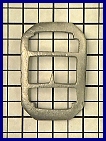 |
These cuprous alloy triple frame shoe buckles from wreck sites of the 1715 fleet both lack their original tongues or tines. The buckles' relatively prosaic designs suggest that these were military, rather than civilian, in use. The bronze example at left has clipped and squared outer and inner frame corners; the brass buckle at right is an early and evolving form of the ovate-recurvate frame shape that became common to Spanish military shoe and knee buckles for decades. | 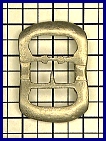 |
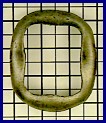 |
The cast brass shoe buckle frame at left was recovered from the cabin wreck site of the 1715 Plate Fleet. It is an exceptionally early example of the oval/recurvate pattern that came to characterize Spanish military shoe and knee buckle frame shapes until the close of the 18th century. Except for its smaller size (shoe buckles became larger through time), there is virtually no difference in the overall configuration of this example from forms used in the 1780s. This specimen was a conventional shoe buckle form of the eighteenth century; its original chape components, consisting of a center pin-mounted hinged and articulated hasp and tongue, are absent. |
| With its hinged central tongue and flanged base, this small buckle from the 1715 Fleet was used to adjust a leather strap such as that used to suspend a dagger or small sword scabbard from a waist belt. In its original state, this example was probably gilded. | 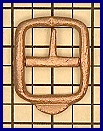 |
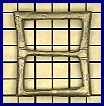 |
These small strap buckles from the 1715 Fleet may have been either military or non-military in application. The flared rectangular form of the example at left closely mimics the shapes of shoe and knee buckles popular during the 1700-1720 period. The design of the strap end buckle at right hearkens to an earlier age; this example may have been made as early as the sixteenth century and remained in use until the time of its loss. |  |
| Closely resembling French and British belt and strap buckles of the period, many Spanish military accoutrement buckles like the one at right assumed a simple but very efficient elongated double ovoid, or "figure eight," configuration. This 1715 specimen has been greatly eroded by nearly three centuries of exposure to the elements; it was originally much more robust in its dimensions. | 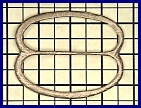 |
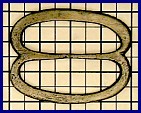 |
The "figure eight" buckle at left is a classic Spanish military strap or belt buckle of the first half of the 18th century. Recovered from the 1724 Quicksilver Fleet, this cast brass double frame buckle's center bar once mounted an iron tongue. Buckle styles did not evolve appreciably during the 1710-1740 period, as examples from the 1733 fleet, shown below, demonstrate. Similar types are recovered from Spanish colonial land sites of the period. |
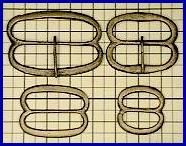 |
Flat cast belt and strap buckles of the ca. 1710-1740 period with elongated "Figure 8" configurations similar to their land-recovered contemporaries (left) are recovered from wreck sites of the 1733 fleet. The buckles' tines were either of hand-drawn brass wire (top) or of iron, which are absent from examples such as those shown at bottom. |
| The example of a Punta Sigüenza recessed brass strap buckle shown at right (see other, ground-recovered examples in the Spanish Military Buckles section of this web site) was recovered from the sunken remains of the Spanish 1733 Fleet. Deceptively modern in appearance, this well-made type saw use from ca. 1730 until the period of the American War for Independence. | 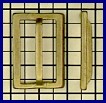 |
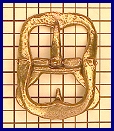 |
This complete brass shoe buckle was recovered from one of the wreck sites of the 1733 Fleet. The ovate/recurvate outer frame contours classic to Spanish military shoe buckles first observed on examples from the 1715 Fleet are retained here. |
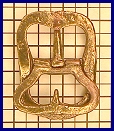 |
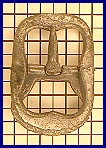 |
The cast pewter shoe buckle shown here features an outer frame configuration almost identical to the 1733 example shown above. This buckle was recovered from a seawater-saturated environment in the immediate vicinity of Castillo El Morro in Puerto Rico and is believed to occupy a temporal placement of ca. 1730-1750. Pewter shoe buckles were not commonly made for or used by the Spanish military establishment, and it is assumed that this example was intended for issue to an enlisted member of a unit whose uniform regulations called for the use of "white metal" metal trim and accessories. |
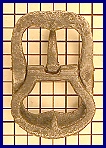 |
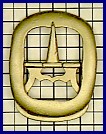 |
From the site of the 1751 Spanish military supply ship Navío San Gerónimo, this is a complete and functioning example of an articulated cast brass Spanish military shoe buckle of the period. The quality of workmanship suggests peninsular Spanish manufacture; the ovate/recurvate frame contours typical of Spanish military shoe buckles, while present, are less pronounced on this example than on most specimens. |
| Other wreck site buckle varieties include the rounded rectangular waist belt or shoulder strap buckle type at left (Navío San Gerónimo, 1751) whose original iron tine has been claimed by the elements. | 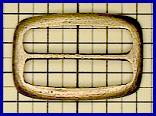 |
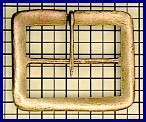 |
Among the artifacts recovered from El Cazador and the 1784 "Asturias" wreck site mentioned previously was the rounded cornered cast brass rectangular waist belt or shoulder strap buckle form shown at right. This is a member of a family of buckle types used by the Spanish regular and provincial military establishment from ca. 1780 through the Napoleonic period. Unusual in that its wire tine is mounted at a notched section on the buckle's outer frame element rather than on its center bar, this configuration is singularly Spanish in design. This is a member of the Gálvez typological family described and more fully illustrated in the buckle section of this web site. |
| The deeply submerged remnants of El Cazador yielded among the earliest marked pieces of Spanish naval insignia known to exist. This crudely cast brass anchor emblem may have adorned a military cartridge box or shoulder strap; it was attached to its presumably leather host via two reverse-mounted drilled brass shanks like those of Spanish military buttons of the period. |
 |
|
|
While none are known to have been recovered from shipwreck sites, this small and delicately fashioned Spanish naval buckle form is believed to have been used on a belt from which was suspended a dirk or dagger for formal, ceremonial, and off-duty use by Spanish naval and marine officers. Only the tongue components of this tongue-and-wreath interlocking buckle typology have thus far been reported. At least some of these cuprous buckles were originally plated with a faux silver white metal alloy. Examples have been recovered at Spanish occupation sites at Gálveztown, Louisiana and Pensacola, Florida. The anchor device embellishing the tongue is very similar to that which adorns both the anchor badge from the wrecksite of El Cazador (shown above) and the anchors included in the design of the 1802 pattern Spanish naval military buttons shown in the marked button section of this website. The dates of manufacture and use of this and other examples of the type are tentatively assigned to the ca. 1790-1810 period. |
